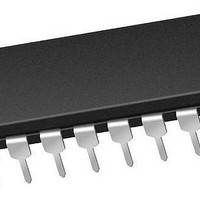PIC24FV16KA301-E/P Microchip Technology, PIC24FV16KA301-E/P Datasheet - Page 200

PIC24FV16KA301-E/P
Manufacturer Part Number
PIC24FV16KA301-E/P
Description
16KB Flash, 2KB RAM, 512B EEPROM, 16 MIPS, 12-bit ADC, CTMU, 5V 20 PDIP .300in T
Manufacturer
Microchip Technology
Series
PIC® XLP™ 24Fr
Datasheet
1.PIC24F16KA301T-ISO.pdf
(320 pages)
Specifications of PIC24FV16KA301-E/P
Processor Series
PIC24FV
Core
PIC
Data Bus Width
16 bit
Program Memory Type
Flash
Program Memory Size
16 KB
Data Ram Size
2 KB
Maximum Operating Temperature
+ 125 C
Mounting Style
Through Hole
Package / Case
PDIP-20
Development Tools By Supplier
MPLAB IDE Software
Minimum Operating Temperature
- 40 C
Core Processor
PIC
Core Size
16-Bit
Speed
32MHz
Connectivity
I²C, IrDA, LIN, SPI, UART/USART
Peripherals
Brown-out Detect/Reset, HLVD, POR, PWM, WDT
Number Of I /o
17
Eeprom Size
512 x 8
Ram Size
2K x 8
Voltage - Supply (vcc/vdd)
3 V ~ 3.6 V
Data Converters
A/D 12x12b
Oscillator Type
Internal
Operating Temperature
-40°C ~ 125°C
Lead Free Status / Rohs Status
Details
- Current page: 200 of 320
- Download datasheet (3Mb)
PIC24FV32KA304 FAMILY
19.3
The real-time crystal input can be calibrated using the
periodic auto-adjust feature. When properly calibrated,
the RTCC can provide an error of less than 3 seconds
per month. This is accomplished by finding the number
of error clock pulses and storing the value into the
lower half of the RCFGCAL register. The 8-bit signed
value loaded into the lower half of RCFGCAL is
multiplied by four and will be either added or subtracted
from the RTCC timer, once every minute. Refer to the
steps below for RTCC calibration:
1.
2.
3.
EQUATION 19-1:
Writes to the lower half of the RCFGCAL register
should only occur when the timer is turned off, or
immediately after the rising edge of the seconds pulse,
except when SECONDS = 00, 15, 30 or 45. This is due
to the auto-adjust of the RTCC at 15 second intervals.
19.4
• Configurable from half second to one year
• Enabled using the ALRMEN bit
• One time alarm and repeat alarm options are
DS39995B-page 200
(Ideal Frequency† – Measured Frequency) *
60 = Clocks per Minute
Note:
(ALCFGRPT<15>)
available
Using another timer resource on the device, the
user must find the error of the 32.768 kHz crystal.
Once the error is known, it must be converted to
the number of error clock pulses per minute.
a) If the oscillator is faster than ideal (negative
result form Step 2), the RCFGCAL register value
must be negative. This causes the specified
number of clock pulses to be subtracted from
the timer counter, once every minute.
b) If the oscillator is slower than ideal (positive
result from Step 2), the RCFGCAL register value
must be positive. This causes the specified
number of clock pulses to be subtracted from
the timer counter, once every minute.
† Ideal Frequency = 32,768 Hz
Calibration
Alarm
It is up to the user to include, in the error
value, the initial error of the crystal: drift
due to temperature and drift due to crystal
aging.
19.4.1
The alarm feature is enabled using the ALRMEN bit.
This bit is cleared when an alarm is issued. Writes to
ALRMVAL should only take place when ALRMEN = 0.
As shown in
alarm is configured
(ALCFGRPT<13:10>). These bits determine which and
how many digits of the alarm must match the clock
value for the alarm to occur.
The alarm can also be configured to repeat based on a
preconfigured interval. The amount of times this
occurs, once the alarm is enabled, is stored in the
ARPT<7:0> bits (ALCFGRPT<7:0>). When the value
of the ARPT bits equals 00h and the CHIME bit
(ALCFGRPT<14>) is cleared, the repeat function is
disabled, and only a single alarm will occur. The alarm
can be repeated up to 255 times by loading
ARPT<7:0> with FFh.
After each alarm is issued, the value of the ARPT bits
is decremented by one. Once the value has reached
00h, the alarm will be issued one last time, after which,
the ALRMEN bit will be cleared automatically and the
alarm will turn off.
Indefinite repetition of the alarm can occur if the
CHIME bit = 1. Instead of the alarm being disabled
when the value of the ARPT bits reaches 00h, it rolls
over to FFh and continues counting indefinitely while
CHIME is set.
19.4.2
At every alarm event, an interrupt is generated. In
addition, an alarm pulse output is provided that
operates at half the frequency of the alarm. This output
is completely synchronous to the RTCC clock and can
be used as a trigger clock to other peripherals.
Note:
CONFIGURING THE ALARM
ALARM INTERRUPT
Changing any of the registers, other than
the RCFGCAL and ALCFGRPT registers,
and the CHIME bit while the alarm is
enabled (ALRMEN = 1), can result in a
false alarm event leading to a false alarm
interrupt. To avoid a false alarm event, the
timer and alarm values should only be
changed while the alarm is disabled
(ALRMEN = 0). It is recommended that
the ALCFGRPT register and CHIME bit be
changed when RTCSYNC = 0.
Figure
19-2, the interval selection of the
2011 Microchip Technology Inc.
through the AMASK bits
Related parts for PIC24FV16KA301-E/P
Image
Part Number
Description
Manufacturer
Datasheet
Request
R

Part Number:
Description:
Manufacturer:
Microchip Technology Inc.
Datasheet:

Part Number:
Description:
Manufacturer:
Microchip Technology Inc.
Datasheet:

Part Number:
Description:
Manufacturer:
Microchip Technology Inc.
Datasheet:

Part Number:
Description:
Manufacturer:
Microchip Technology Inc.
Datasheet:

Part Number:
Description:
Manufacturer:
Microchip Technology Inc.
Datasheet:

Part Number:
Description:
Manufacturer:
Microchip Technology Inc.
Datasheet:

Part Number:
Description:
Manufacturer:
Microchip Technology Inc.
Datasheet:

Part Number:
Description:
Manufacturer:
Microchip Technology Inc.
Datasheet:










